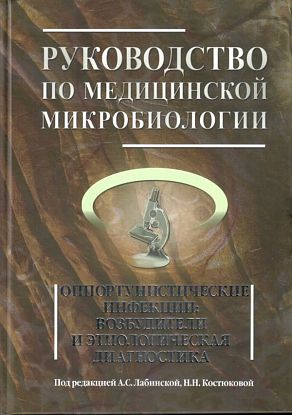Medical Microbiology Guidance. Book III, Volume 1. Opportunistic Infections: Agents and Etiological Diagnostics. Under the editorship of A.S. Labinskaya and N.N. Kostyukova. Moscow, Binom, 2013, 752 p.
 The team of authors includes leading microbiologists and epidemiologists of N.F. Gamaleya Institute for Epidemiology & Microbiology – N.N. Kostyukova (editor), Y.F. Belykh, V.M. Bondarenko, O.A. Dmitrenko, N.V. Karazhas, A.F. Moroz, T.I. Sergeyeva, A.Y. Snegireva, I.S. Tartakovsky.
The team of authors includes leading microbiologists and epidemiologists of N.F. Gamaleya Institute for Epidemiology & Microbiology – N.N. Kostyukova (editor), Y.F. Belykh, V.M. Bondarenko, O.A. Dmitrenko, N.V. Karazhas, A.F. Moroz, T.I. Sergeyeva, A.Y. Snegireva, I.S. Tartakovsky.Recommended by the Academic and Methodological Association for Medical and Pharmaceutical Education of Higher Educational Establishments of Russia as a learning aid for the system of postgraduate education of doctors.
The guidance contains the current data on bacterial and mycotic agents of the most widespread opportunistic infections, including hospital-acquired infections as well as the methods of etiological diagnostics.
The authors are the leading Russian specialists in studies of opportunistic infection agents – bacteria and fungi. The volume contains an introductory part and a part devoted to certain groups of microorganisms as well as a section regarding the normal human flora.
The introductory part contains the current definition of an opportunistic infection, its species composition, factors resulting in generation and dissemination of the agents.
In the part devoted to the agent, gram-positive and gram-negative, aerobic and anaerobic bacteria, opportunistic fungi, and protozoans are described. Formulations of the substrates and the reagents required for diagnostics of opportunistic infections are given.
For certain agents, the current data on their biological properties are summarized, including pathogenicity and its genetic regulation, sensitivity and resistance to antibiotics, methods of microbiological diagnostics and sensitivity testing. The pathogenesis and the key clinical signs of the infections caused by certain agents are briefly described as well as the methods of their causal treatment. The data on the sources and the paths of certain infections are specified.
The book is intended for medical microbiologists, researchers, teachers of higher educational establishments and participants of the system, of postgraduate education for doctors.